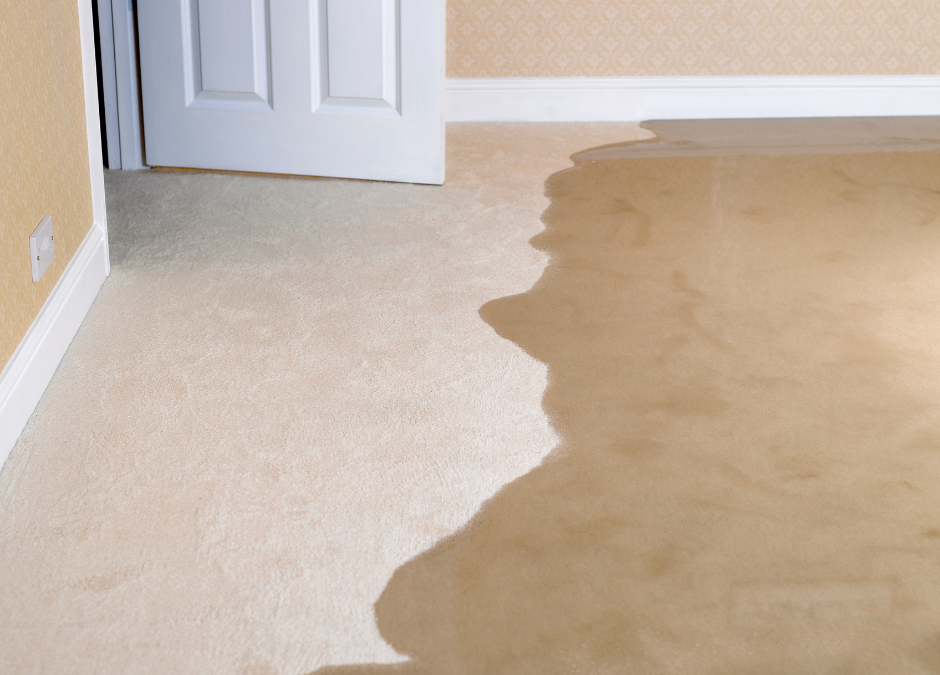
Does Steam Cleaning Improve Indoor Air Quality
September 19, 2023
How to Increase the Lifespan of Your Area Rug
October 2, 2023Water damage can be a significant concern for homeowners, and one particularly vulnerable area is carpets. If left unattended, water damage to your carpets can lead to serious issues, including damage to the floorboards and the growth of harmful mold. However, taking quick action can make all the difference.
It’s not just carpets that are at risk; broader structural elements like walls and foundations can also suffer. Carpets, in particular, are quick to soak up water, creating an ideal environment for harmful microbes. To salvage these essential parts of your home, you must act promptly, conduct a thorough assessment, and use the right restoration techniques.
The level of water contamination plays a crucial role in determining how to restore your carpets. In this guide, we’ll walk you through fixing water-damaged carpets to help you restore your living space.
Act Fast
Time is of the essence when dealing with water-damaged carpets. The longer water lingers, the greater the potential for structural damage and mold growth. Take immediate action as soon as you notice water damage, whether from a leak, flood, or another source.
Start by shutting off the water source if it’s a plumbing issue and ensuring safety in the affected area. The sooner you begin the restoration process, the better your chance of salvaging your carpets and preventing further harm to your home.
Assess the Damage
Carefully examine the extent of the water damage on your carpets. Take note of particularly saturated areas where the water may have seeped through to the padding or subfloor. Use a moisture meter or a clean, white cloth to test the dampness of the carpet. Press the cloth against the carpet and see if it picks up any moisture.
Check for signs of discoloration, warping, or odors that may indicate prolonged exposure to moisture. Additionally, inspect the surrounding areas, like walls and baseboards, for any signs of water damage. This assessment will help you determine the level of restoration needed and whether some sections of the carpet may need to be replaced entirely.
It’s crucial to develop an effective restoration plan for your water-damaged carpets. Remember to document the damage with photographs for insurance purposes if necessary.
Remove all Excess Water/Moisture
After water gets into your carpet, it’s crucial to promptly remove the excess moisture. The method you use depends on how wet the carpet is. If your carpet is fully soaked, consider using a sump pump or shop vac to remove as much water from your carpet as possible.
The sump pump efficiently removes a significant amount of water, while the shop vac, designed for water removal, is perfect for less saturated areas. In smaller water damage areas, a shop vac may suffice. Unlike regular vacuums, it’s built to handle water. You can usually rent these tools at hardware stores.
But if you’re looking for a stress-free solution, hiring professionals with the right equipment can be a wise option.
Deep Cleaning and Sanitizing
Deep cleaning and sanitizing are your companions when it comes to getting your water-damaged carpets back in shape. You can opt for a commercial carpet cleaner or a mix of mild detergent and water to give those affected areas some.
Remember to scrub gently; you don’t want to soak the carpet too much and cause more trouble. Consider using an antimicrobial solution or a special carpet sanitizer for an extra layer of protection. Just be sure to follow the manufacturer’s instructions for these cleaning products.
Prevent Future Water Damage
To avoid future water damage to your carpets, take preventive measures. Regularly inspect your home for leaks, damaged pipes, or areas prone to flooding.
Ensure that your home’s drainage systems are functioning correctly and that your roof is in good condition to prevent water infiltration. Invest in quality doormats and encourage family members and guests to wipe their feet before entering your home to minimize the amount of moisture and dirt brought indoors.
Consider using waterproof mats in areas susceptible to spills, such as kitchens and bathrooms. Being proactive in preventing water damage can save you from the hassle and expense of dealing with water-damaged carpets in the future.
Let Your Carpets Dry Properly
After tackling the water damage, let your carpets dry thoroughly. Open windows and doors for better airflow.
If you have a dehumidifier or a fan, use them to speed up drying. Dehumidifiers reduce humidity, while fans enhance air circulation.
Remember, drying takes time. Ensure your carpet is completely dry before walking on it or moving furniture back. A moisture meter can help confirm dryness.
Be patient; your carpets will get there. Proper drying prevents mold and mildew. So, let them air out, and soon, your carpets will be cozy and dry again.
Seek Expert Assistance from Premier Carpet Cleaning
Restoring water-damaged carpets can sometimes be complex, especially when the damage is extensive or if you’re unsure about the restoration process. That’s where we come in! Don’t hesitate to contact Premier Carpet Cleaning, your trusted carpet
Our team has the knowledge, experience, and top-notch equipment to handle even the most challenging situations. We’ll assess the damage, implement effective restoration techniques, and ensure your carpets are back in their best condition.
So, if you face water-damaged carpets needing expert care, take action today. Contact premium Carpet Cleaning and let us restore your carpets to their former glory!

